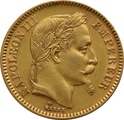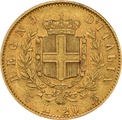Latin Monetary Union
The Latin Monetary Union was established in a treaty between France, Belgium, Switzerland and Italy (including the Papal States) in 1865. The aim of the Latin Monetary Union was to enhance trade between the various countries by standardising the weight and dimensions of their coinage. It came into effect on August 1st, 1866, and ended 61 years later in 1927.
Members of the Latin Monetary Union, as well as countries following their regulations, included: France, Italy, Switzerland, Belgium, Spain, Austria-Hungary, Greece, Romania, and Serbia.
The treaty was possible because at this time the signatories, as well many other nations, used a bi-metallic standard. In a bi-metallic monetary standard, gold and silver coins were equal in value as a currency to their value as a precious metal.
Coins were literally worth their weight in, and were exchangeable for, gold and silver. Members of the Latin Monetary Union further agreed to standardise the size, weight and fineness of their coins. The idea behind this was that, as gold and silver had the same value in any country, the standardised coins became more easily interchangeable. Removing the need to weigh a coin, and verify its purity, would significantly speed up the process for traders in each country.
Latin Monetary Union coins
Preceding the Latin Monetary Union, gold and silver had long maintained an approximate exchange rate of 1 part gold to 15.5 of silver. This gold-silver ratio was adopted as a fixed standard by members of the Latin Monetary Union for all future transactions.
Following the Napoleonic conquests, the gold 20 French Franc coin - first minted in 1803 - had been accepted in many European nations. It was therefore adopted by member states as the benchmark for all their minted coins.
The standard gold coin was set at 2.90322 grams of fine gold. Like British pounds, it was divisible into twenty single units. Larger gold coins were generally 6.451 grams, with 5.806 grams of pure gold, at a purity of 900 fineness (90%).
The weight and dimensions of the the gold 20 French Franc coin were the standard for Latin Monetary Union coinage.
The largest silver coinage of 5 Italian Liras and French, Swiss or Belgian Francs, were all struck from 900 fineness silver, while fractional silver coins were minted from 835 fineness silver.
Development of the Union
Many French colonies joined or followed the LMU standards. Greece formally joined the Union in 1867 and conformed its currency, the Drachma, to the group’s regulations.
Following unsuccessful negotiations, Spain and Romania remained outside of the Union officially but followed many of its practices. Austria-Hungary also remained outside the Union, but entered into a separate currency agreement with France. This resulted in it also following many of the Union's monetary standards.
Other nations including Bulgaria, Finland, Serbia, as well as Latin American countries such as Peru, Colombia and Venezuela, adopted the Union’s standards but did not join officially.
Map showing the global extent of the Latin Monetary Union.
The end of the Latin Monetary Union
The Papal States in Italy minted silver coins of inferior purity to the Union's standard, which meant it was excluded from the Union in 1870 and left owing the Union 20 million lire.
The Union had begun following a long period of stability in the value of gold and its ratio to silver, but this ended in 1873 at the start of the 'Long Depression'. The value of silver fell drastically, and this economic depression continued until around 1895.
At this time, the United States of America abandoned the bi-metallic standard and switched solely to a gold standard. In the same year, the newly-unified Germany introduced the gold Mark, and thereby also abandoned a bi-metallic standard.
The fall in silver prices caused many of the Union’s nations to cease minting silver coins in 1878. Like the US and Germany, Latin Monetary Union nations entered into the international gold standard. This therefore abandoned one of the major principles of the Treaty, but the LMU continued to function for a few more decades.
Economic history shows that difficulties in Greece meant it was unable to conform to the Union's standards, and officially left the Latin Monetary Union in 1910.
Despite all these setbacks, it was the First World War and the ensuing economic crises that finally ended the Union, legally ending in 1927.
Economic historical timeline of the Latin Monetary Union.
Legacy of the Latin Monetary Union
The original intention of the Union was to foster trade between member nations. Author H.P. Willis – who wrote 'A History of the Latin Monetary Union' – and other economists and historians conclude that it did little to improve trade. Instead, they cite the bi-metallic, gold and silver standard (and later gold standard) as being far more influential.
Some also see the Union as a forerunner to the European Union and the Euro currency. This is a very questionable view though. The Latin Monetary Union was far from a single common currency. In the Latin Monetary Union, each country maintained its own currency, each nation was independent, and there was no economic integration. It was not a single currency union, instead it was reliant upon, and in many ways was simply an extension of, the bi-metallic standard.
At BullionByPost we stock a wide range of collectable historic coins from several members of the Latin Monetary Union. In our world coins section, you can find many fine examples of coins from the Latin Monetary Union.
- How To Buy Gold
- How to Buy?
- Payment Options
- Delivery Options
- Gold Storage
- Storage at Brink's
- Gold Investment Guide
- Why buy gold?
- Is gold a good investment?
- Why physical gold?
- Best time to buy gold?
- Gold bars vs coins?
- Gold vs Silver
- Gold - Silver Ratio explained
- VAT on bullion
- CGT on bullion
- Legal tender coins
- Top 5 Gold Investments
- Top 5 Silver Investments
- Gold vs ISAs
- Gold vs Buy-to-Let
- Gold vs FTSE 100
- Gold vs Bitcoin
- Where to buy gold?
- Why buy from us?
- Where to sell gold?
- Coin Shops
- Gold Price Forecasts
- Top 10 Gold Producers
- Top 10 Gold Reserves
- Gold Britannia vs Sovereign
- Britannia coin designs
- Sovereign coin designs
- Sovereign Mintages
- Sovereign mint marks
- British coin specs
- What is a proof coin?
- Royal Mint bullion
- The Queen's Beasts
- Royal Mint Lunar Coins
- Bullion Refiners
- British coin mints
- Krugerrands
- Gold Tola - India & Pakistan
- Bullion Index










